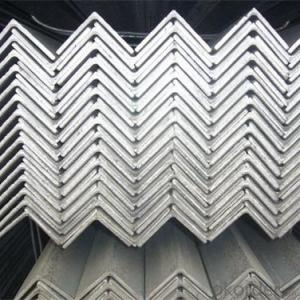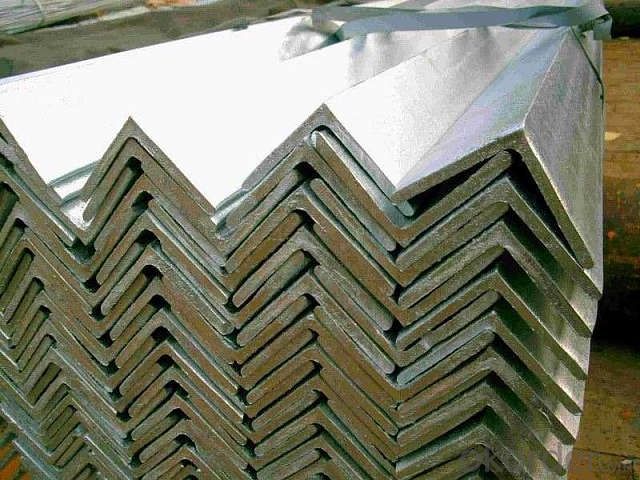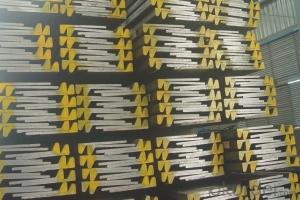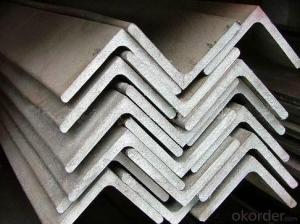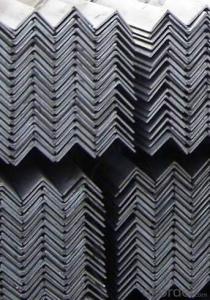Hot Rolled Equilateral Small Angle Steel
- Loading Port:
- Tianjin
- Payment Terms:
- TT or LC
- Min Order Qty:
- 25 m.t.
- Supply Capability:
- 2000 m.t./month
OKorder Service Pledge
OKorder Financial Service
You Might Also Like
Product Description:
OKorder is offering Hot Rolled Equilateral Small Angle Steel at great prices with worldwide shipping. Our supplier is a world-class manufacturer of steel, with our products utilized the world over. OKorder annually supplies products to European, North American and Asian markets. We provide quotations within 24 hours of receiving an inquiry and guarantee competitive prices.
Product Applications:
Hot Rolled Equilateral Small Angle Steel are ideal for structural applications and are widely used in the construction of buildings and bridges, and the manufacturing, petrochemical, and transportation industries.
Product Advantages:
OKorder's Hot Rolled Equilateral Small Angle Steel are durable, strong, and resist corrosion.
Main Product Features:
· Premium quality
· Prompt delivery & seaworthy packing (30 days after receiving deposit)
· Corrosion resistance
· Can be recycled and reused
· Mill test certification
· Professional Service
· Competitive pricing
Product Specifications:
Manufacture: Hot rolled
Grade: Q195 – 235
Certificates: ISO, SGS, BV, CIQ
Length: 6m – 12m, as per customer request
Packaging: Export packing, nude packing, bundled
Chinese Standard (H*W*T) | Weight (Kg/m) | 6m (pcs/ton) | Light I (H*W*T) | Weight (Kg/m) | 6m (pcs/ton) | Light II (H*W*T) | Weight (Kg/m) | 6M |
100*68*4.5 | 11.261 | 14.8 | 100*66*4.3 | 10.13 | 16.4 | 100*64*4 | 8.45 | 19.7 |
120*74*5.0 | 13.987 | 11.9 | 120*72*4.8 | 12.59 | 13.2 | 120*70*4.5 | 10.49 | 15.8 |
140*80*5.5 | 16.89 | 9.8 | 140*78*5.3 | 15.2 | 10.9 | 140*76*5 | 12.67 | 13.1 |
160*88*6 | 20.513 | 8.1 | 160*86*5.8 | 18.46 | 9 | 160*84*5.5 | 15.38 | 10.8 |
180*94*6.5 | 24.143 | 6.9 | 180*92*6.3 | 21.73 | 7.6 | 180*90*6 | 18.11 | 9.2 |
200*100*7 | 27.929 | 5.9 | 200*98*6.8 | 25.14 | 6.6 | 200*96*6.5 | 20.95 | 7.9 |
220*110*7.5 | 33.07 | 5 | 220*108*7.3 | 29.76 | 5.6 | 220*106*7 | 24.8 | 6.7 |
250*116*8 | 38.105 | 4.3 | 250*114*7.8 | 34.29 | 4.8 | 250*112*7.5 | 28.58 | 5.8 |
280*122*8.5 | 43.492 | 3.8 | 280*120*8.2 | 39.14 | 4.2 | 280*120*8 | 36.97 | 4.5 |
300*126*9 | 48.084 | 3.4 | 300*124*9.2 | 43.28 | 3.8 | 300*124*8.5 | 40.87 | 4 |
320*130*9.5 | 52.717 | 3.1 | 320*127*9.2 | 48.5 | 3.4 | |||
360*136*10 | 60.037 | 2.7 | 360*132*9.5 | 55.23 | 3 |
FAQ:
Q1: Why buy Materials & Equipment from OKorder.com?
A1: All products offered byOKorder.com are carefully selected from China's most reliable manufacturing enterprises. Through its ISO certifications, OKorder.com adheres to the highest standards and a commitment to supply chain safety and customer satisfaction.
Q2: How do we guarantee the quality of our products?
A2: We have established an advanced quality management system which conducts strict quality tests at every step, from raw materials to the final product. At the same time, we provide extensive follow-up service assurances as required.
Q3: How soon can we receive the product after purchase?
A3: Within three days of placing an order, we will begin production. The specific shipping date is dependent upon international and government factors, but is typically 7 to 10 workdays.
Q4: What makes stainless steel stainless?
A4: Stainless steel must contain at least 10.5 % chromium. It is this element that reacts with the oxygen in the air to form a complex chrome-oxide surface layer that is invisible but strong enough to prevent further oxygen from "staining" (rusting) the surface. Higher levels of chromium and the addition of other alloying elements such as nickel and molybdenum enhance this surface layer and improve the corrosion resistance of the stainless material.
Q5: Can stainless steel rust?
A5: Stainless does not "rust" as you think of regular steel rusting with a red oxide on the surface that flakes off. If you see red rust it is probably due to some iron particles that have contaminated the surface of the stainless steel and it is these iron particles that are rusting. Look at the source of the rusting and see if you can remove it from the surface.
Images:
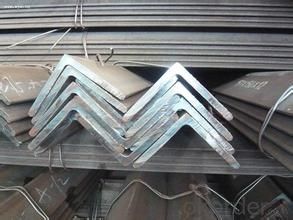

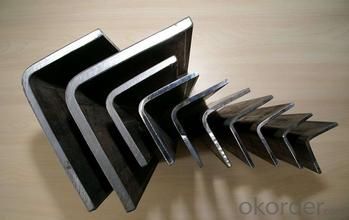
- Q:Are steel angles available in non-standard dimensions?
- Yes, steel angles are available in non-standard dimensions.
- Q:How do steel angles perform in extreme temperatures?
- Steel angles are known for their excellent performance in extreme temperatures. Due to their high melting point, steel angles can withstand both extremely high and low temperatures without losing their structural integrity. In extreme heat, steel angles have a high resistance to thermal expansion, meaning they maintain their shape and strength even when exposed to intense heat. Similarly, in extremely cold temperatures, steel angles do not become brittle or weak, ensuring their durability and reliability. This makes steel angles ideal for applications in industries such as construction, automotive, and aerospace, where they are exposed to a wide range of temperatures. Additionally, steel angles also exhibit excellent fire resistance, further enhancing their performance in extreme temperature conditions. Overall, steel angles are a preferred choice for applications requiring stability and strength in extreme temperatures.
- Q:Can steel angles be used as reinforcement in concrete structures?
- Indeed, reinforcement in concrete structures can be achieved by utilizing steel angles. These angles, typically in the shape of L or angles, are inserted into the concrete to bolster its strength and provide support to the structure. By resisting tensile forces, these angles effectively prevent concrete from cracking or failing. They find extensive use in various applications like beams, columns, and walls, significantly enhancing the structural integrity and load-bearing capacity of these concrete components. Moreover, the ease with which steel angles can be welded or bolted together makes them a flexible and economical choice for reinforcing concrete structures.
- Q:How do you calculate the critical buckling load for a steel angle?
- To calculate the critical buckling load for a steel angle, you need to consider the properties of the angle section and its interaction with the applied loads. The critical buckling load is the maximum load that the angle section can withstand before it buckles or fails in a lateral-torsional mode. The first step is to determine the section properties of the steel angle, including its moment of inertia (I) and section modulus (Z). These properties can be obtained from standard structural design tables or through mathematical calculations. Next, you need to consider the effective length factor (K) for the angle section. The effective length factor takes into account the end conditions of the angle and how it is restrained against buckling. Different end conditions have different values for K, which can be determined from design codes or engineering references. Once you have determined the section properties and effective length factor, you can use the Euler's buckling equation to calculate the critical buckling load. The Euler's buckling equation is given by: Pcr = (π^2 * E * I) / (K * L^2) Where: Pcr is the critical buckling load π is a mathematical constant (approximately 3.14159) E is the modulus of elasticity of the steel I is the moment of inertia of the angle section K is the effective length factor L is the unsupported length of the angle section By plugging in the appropriate values for E, I, K, and L into the equation, you can calculate the critical buckling load for the steel angle. It is important to note that the critical buckling load is a theoretical value and should be compared to the actual applied loads to ensure that the angle section is safe and will not buckle under the given conditions.
- Q:Can steel angles be used as structural supports?
- Indeed, structural supports can be provided by steel angles. Construction and engineering projects frequently employ steel angles due to their remarkable strength and stability. Their distinctive L-shape design renders them perfectly suited for lending support and ensuring structural integrity to various structures. Buildings, bridges, and other infrastructure projects often incorporate steel angles as beams, braces, or supports. These angles are capable of bearing heavy loads and resisting bending and compression forces, thereby establishing themselves as a dependable choice for structural support. Moreover, the ease of fabrication and installation associated with steel angles renders them a cost-effective solution for construction purposes.
- Q:Can steel angles be used for support brackets in electrical installations?
- Yes, steel angles can be used for support brackets in electrical installations. Steel angles are commonly used in construction and can provide sturdy support for various applications, including electrical installations. They are strong, durable, and can withstand the weight and stress associated with supporting electrical components or fixtures. Steel angles can be easily mounted to walls, ceilings, or other surfaces, providing a stable base for electrical equipment such as junction boxes, conduit, or cable trays. Additionally, steel angles can be customized and fabricated to meet specific installation requirements, making them a versatile choice for support brackets in electrical installations.
- Q:Can iron angle steel be welded with stainless steel angle steel?
- Iron angle steel and stainless steel angle welding are not difficult.
- Q:How do steel angles perform under lateral or wind loading conditions?
- Steel angles are commonly used in construction for their ability to withstand lateral or wind loading conditions. Due to their shape and structural design, steel angles offer excellent resistance against bending and twisting forces. They distribute the applied loads efficiently, ensuring stability and minimizing any potential structural damage. Overall, steel angles are reliable and perform exceptionally well under lateral or wind loading conditions.
- Q:What are the common methods of surface finishing for steel angles?
- The common methods of surface finishing for steel angles include galvanizing, painting, powder coating, and shot blasting.
- Q:What are the different standards for steel angles?
- There are several different standards for steel angles, which are commonly used in construction and industrial applications. One of the most widely recognized standards is the American Society for Testing and Materials (ASTM) standard. ASTM A36 is a common grade for steel angles and specifies the chemical composition, mechanical properties, and tolerances for these structural shapes. It is commonly used for general structural purposes and is available in various sizes and lengths. Another prominent standard is the European standard, known as EN 10025. This standard includes several grades of steel angles, such as S235, S275, and S355, which correspond to different yield strengths. EN 10025 steel angles are widely used in construction, machinery, and engineering industries across Europe. In addition to these standards, there are also country-specific standards, such as the Japanese Industrial Standards (JIS) and the British Standards (BS). JIS G3101 is a well-known standard in Japan, which specifies the hot-rolled steel angles for general structures. BS EN 10056 is a British standard that provides specifications for steel angles used in construction. Furthermore, there are specialized standards for specific applications, such as marine-grade steel angles that are resistant to corrosion in saltwater environments. These standards, like ASTM A588, provide additional requirements for chemical composition and mechanical properties to ensure the steel angles' durability in harsh conditions. Overall, the different standards for steel angles ensure that these structural shapes meet specific requirements for strength, durability, and compatibility with various construction and industrial applications. It is crucial to refer to the appropriate standard when selecting steel angles to ensure they meet the necessary specifications for the intended use.
1. Manufacturer Overview |
|
|---|---|
| Location | |
| Year Established | |
| Annual Output Value | |
| Main Markets | |
| Company Certifications | |
2. Manufacturer Certificates |
|
|---|---|
| a) Certification Name | |
| Range | |
| Reference | |
| Validity Period | |
3. Manufacturer Capability |
|
|---|---|
| a)Trade Capacity | |
| Nearest Port | |
| Export Percentage | |
| No.of Employees in Trade Department | |
| Language Spoken: | |
| b)Factory Information | |
| Factory Size: | |
| No. of Production Lines | |
| Contract Manufacturing | |
| Product Price Range | |
Send your message to us
Hot Rolled Equilateral Small Angle Steel
- Loading Port:
- Tianjin
- Payment Terms:
- TT or LC
- Min Order Qty:
- 25 m.t.
- Supply Capability:
- 2000 m.t./month
OKorder Service Pledge
OKorder Financial Service
Similar products
New products
Hot products
Hot Searches
Related keywords
